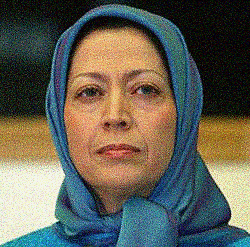
Maryam Rajavi, president-elect of MEK front group the National Council of Resistance of Iran.
The MEK supporters who saw these fact sheets reacted with varying levels of outrage. I was accused of being in the pay of the Iranian government (and if not the regime in Tehran, then it surely had to be someone), and, somewhat paradoxically, I was also accused of spreading “Rush Limbaugh propaganda.” I suppose this was because the MEK is often said to be ideologically “Islamo-Marxist,” a label composed of two elements that find considerable disfavor among Limbaugh and his cohorts, even if he and his ilk are not usually averse to war with Iran. In any case, it made little sense. Shortly thereafter, in calmer but seemingly endless conversations with MEK supporters, I heard a repeated list of red herrings having to do with the malevolence of the Iranian regime and the plight of the MEK members at Camp Ashraf, who are apparently in many cases relatives and friends of those demonstrating in Washington. I assured my interlocutors that I shared their disdain for the regime in Tehran, and I did not want any misfortune to befall the residents of Camp Ashraf. They barely addressed the organization’s rap sheet, and they seemed to completely miss the most obvious point: if the MEK is removed from the terrorist list, and is subsequently supported (officially or otherwise) by Americans and Israelis in a war with Iran’s government, then the Iranians would ensure Camp Ashraf’s rapid and bloody destruction.
Surely enough, in recent weeks the United Nations and the Obama administration have moved ahead with a plan similar to the course of action I tried to promote to the MEK members/supporters in front of the White House: under UN supervision, the 3,200 residents of Camp Ashraf will be moved to Camp Liberty, a recently vacated American base in Baghdad. From there, they will be processed and resettled. Some members with little “political baggage” are apparently willing to return to Iran; others will build new lives in their adopted country of Iraq; and others will be resettled elsewhere in the world. The MEK’s Paris-based leadership seems to be reluctantly cooperating, as is the Iraqi government, though the situation is still very tense and unsettled.
All of this is probably a pragmatic move on the Obama administration’s part. If the MEK members are first moved away from the border with Iran, and then out of the country entirely, that lowers the possibility of an incident on the border exploding into uncontrollable violence. On top of that, the Iraqi government seemed determined to close Camp Ashraf by any means necessary by the end of 2011, thus presenting the administration with a fait accompli: Obama could not allow Republicans (and others) to blame his administration for the humanitarian catastrophe if a group of so-called “Iranian freedom fighters” were massacred by the new Iraqi government, acting without the oversight of American troops. It would matter not that the withdrawal date was decided upon by the Bush administration, as Obama’s opponents would doubtlessly condemn him for fecklessly abandoning a group of rebels who oppose the enemy du jour.
Proponents of the invasion of Iraq often referred to the oppression of Iraq’s Kurds (and, less often, Shi’a) as an example of why Saddam Hussein should be deposed by force. Now, some of the same people, and their ideological brethren, extol the virtues of an organization with a leader (Maryam Rajavi) who is on record as instructing her followers to “Take the Kurds under your tanks” during the MEK’s period of fighting alongside Saddam Hussein. Even if the MEK is entirely removed from Iraq, they will likely continue their aggressive and well-funded lobbying in the US and Europe for the time being. If their behavior and demeanor at their demonstrations is anything to go by, they are thoroughly convinced of the righteousness of their cause, delusional enough to believe they can one day hold power in Iran, and unlikely to care about any collateral damage they create.
(My Life with the Thrill Kill Kult is an industrial rock band from Chicago. — Ed.)
Scott Charney is a contributor to Foreign Policy in Focus.
